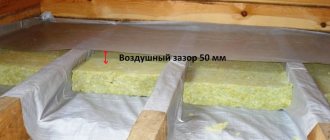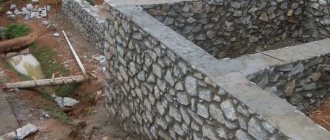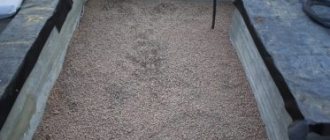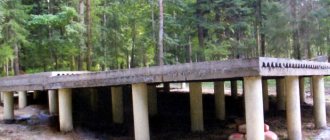what it should be like and what materials it can be made from.
General information about what bedding is
As you know, the foundation is the foundation of a house, and not just a foundation, but the main and most important part in the entire construction process of a private house. If for some reason the foundation is made poorly or even of poor quality, then without complying with important building rules and regulations it will soon become unsuitable for use, and the house simply cannot be lived in. In addition, the frames on the windows will begin to warp, the walls will crack, and the doors will no longer close normally, which can lead to the formation of drafts.
It is for this reason that it is very important to make a foundation that will be of high quality and comply with all rules and regulations. One of the guarantees that the foundation will be strong, strong and reliable, that it will be able to stand for many years without deterioration in characteristics, is that the bedding is made competently and with high quality. It is thanks to it that the foundation will be ensured with reliability and durability for housing as a whole.
What should be the bedding?
Now you have learned that bedding under a concrete foundation is an extremely important and necessary element during the construction of various structures and buildings. You need to figure out how to make a bedding that will comply with all rules and regulations. To begin with, you should know that the bedding, which is also called a substrate and a pillow, is usually installed under a strip foundation. To create it, you should dig a trench of suitable size in advance. If you look at the construction requirements and standards that are applicable abroad, you will see that European experts advise making a foundation cushion with a thickness of 0.25 meters. He believes that this is quite enough so that the foundation and bedding can fully perform all their intended functions.
Now let's return to Russian realities, where European standards are not always acceptable. If you look at the experience of builders in the Motherland, almost everyone will tell you that the thickness of the foundation bedding will depend on the type of soil on the site. Depending on the characteristics of the soil, the thickness of the substrate ranges from 0.3 to 0.6 meters, and in special cases, in order to create additional insulation and safety net, the thickness of the pillow can be up to 0.8 meters.
Please note that the greater the thickness of the bedding under the strip foundation, the less the foundation of the house will deform and collapse in the future, which most often occurs due to soil heaving.
The substrate can be made of crushed stone, sand and concrete, although most often only sand is used for arrangement. Such a sand cushion needs to be compacted carefully and tightly. In addition, when laying such a pillow, it should be compacted gradually, in layers, and this is done so that in the future there is no shrinkage and deformation of the foundation of the building. In the photo you can see the construction of a monolithic slab foundation on a sand bed.
It should be borne in mind that when creating a backfill for a strip or pile foundation, the selected material should be gradually poured, i.e. layers with a thickness of 0.2 meters, and then thoroughly compacted using special tools like rollers or an area vibrator. The density of the finished substrate for the foundation must be no less than 1600 kg/m3.
You should also pay special attention to the fact that sometimes builders use a material such as clay to construct a sand cushion, and to do this, compact a layer of it into a dug hole. According to these experts, clay helps protect the foundation of the house if for some reason groundwater begins to rise, but in reality this is not at all the case. In reality, the water will be retained under a layer of clay and will not reach the foundation, but this is even harmful, as it will cause the heaving of the soil to increase.
What should be the correct bedding?
Now you know that bedding for a concrete foundation is a very important and definitely necessary element in the construction of various buildings and structures. You need to figure out how to make a bedding that meets all the rules and regulations.
Diagram of a strip foundation on a sand bed.
First you need to know that the bedding (pillow, substrate), as a rule, is placed under a strip-type foundation. In order to create it, you must first dig a suitable trench.
If you look at foreign construction requirements and standards, you can see that European experts recommend making a cushion under the foundation with a thickness of 25 cm. According to them, this value is enough for the bedding and foundation to fully fulfill their functions.
However, European standards are not always acceptable for Russian realities. If you look at the experience of domestic builders, they almost unanimously declare that the thickness of the foundation fill depends, first of all, on the type of soil on the site. Depending on the characteristics of the soil, the thickness of the substrate can range from 30 to 60 cm. In some cases, to provide additional security, it is recommended to increase the thickness of the foundation cushion to 80 cm.
The greater the thickness of the foundation bedding, the less the foundation of the house itself will deform and collapse in the future, which, as a rule, occurs due to soil heaving.
The substrate can be made of sand, crushed stone and concrete. Most often, sand is used for its construction. Such a pillow needs to be compacted tightly and thoroughly. In addition, when laying such a pillow, it must be compacted gradually, layer by layer. This is done to prevent further settlement and deformation of the base of the building.
Diagram of the construction of a slab monolithic foundation on a sand cushion.
It must be borne in mind that when making a pillow for a foundation, the material from which it is made is poured gradually, in layers 20 cm thick, after which it is very carefully compacted using rollers or area vibrators specially designed for this work. The density of the finished foundation cushion must be at least 1.6 t/m³.
It is necessary to pay special attention to the fact that some builders advise using clay to construct a sand cushion. In this case, a layer of clay is compacted into the dug hole. According to such experts, clay can protect the foundation of a house if groundwater suddenly begins to rise. However, it is not. In practice, water will indeed linger in the clay layer and will not rise to the foundation, but this is very harmful, as it contributes to a significant increase in the heaving of the soil.
Preparing for the installation of a foundation substrate
A cushion of sand, crushed stone or concrete under the foundation performs several extremely important functions, namely:
- Water drainage. A sand cushion for the foundation helps ensure high-quality drainage of water that may begin to accumulate under the foundation, which will significantly reduce the impact of soil heaving forces.
- Uniform load distribution. The backfill helps to create a uniform distribution of pressure from the foundation of the house to the ground, and also helps to increase the resistance of the foundation several times and serves to level it.
If your house will have a basement or any other basement, we recommend connecting the bedding to the base of the house by installing vertical reinforcement or using a profiled connection. A foundation made on a sand bed must be waterproofed on top. If the house is built on land that is subject to severe heaving, then the base should be reinforced on top of the foundation, namely an armored belt made of iron and concrete.
If you are planning to build a frame structure for a house, then special carved pins, called anchors, must be walled into the foundation strip itself. This makes it possible to ensure excellent adhesion between the frame walls of the house and the base, which will be characterized by the design features. Anchors are also required for use when installing reinforcement that will fasten the foundation of the house to the reinforced belt located between the floors. Such fittings should be installed strictly vertically.
What sand should I use?
In essence, the backfill for a sand foundation is a foundation, i.e. the base of the foundation. For this reason, it should only be done after the foundation trench has been dug. The depth of the trench, as already mentioned, will depend on the composition of the soil on which the house will be built. When it is ready, it needs to be further deepened by 0.15-0.3 meters and covered with a layer of sand. Certain sources that talk about making a substrate recommend using medium-grained and fine-grained sand for backfilling. But real experts recommend buying only coarse-grained sand for these purposes, since over time the fine fraction will begin to shrink, but large grains of sand can retain their excellent qualities. You can also use ordinary river sand, which is classified as the middle fraction.
If for some reason wet sand gets into the trench, you don’t have to compact it, as it will compact on its own. If you take dry sand, you should definitely moisten it and compact it thoroughly. In this case, it should be poured in portions, and then compact each layer of sand. The quality of the foundation bedding can be easily checked - if a person walks on such a bedding and no traces are left, then you have compacted the backing perfectly.
Also, do not forget about the role played by the level of groundwater. For each region, the values are different, and if in the place where the foundation is installed it is higher, then the thickness of the bedding under the foundation should be increased. It is also worth paying attention not just to the evenness of the substrate, but also to the horizontalness. This can be checked using a building level. Before backfilling with sand, builders advise laying geotextiles or roofing felt at the bottom of the trench. The purpose of such bedding is to ensure that the sand does not mix with the ground.
Why do you need bedding?
It is somewhat incorrect to raise the question of choosing a backfill for a foundation made of sand or crushed stone. The key to a strong and stable house is a strong and reliable foundation, which must meet a number of requirements:
- High strength and density of the soil, capable of withstanding the distributed load of further development;
- Groundwater should not linger under the foundation, therefore the high drainage capacity of the soil is important;
- When wet or dry, the base should not lose its basic characteristics.
- It should not contain organically active components;
- The presence of flammable or rotting plant residues is not allowed.
- Cold heaving of the soil is not allowed;
- Uneven shrinkage or deformation is not allowed.
During construction work, the foundation should not deform even under the load of the construction equipment involved or the activity of builders.
The strength of the surface layer should be sufficient to accommodate all the necessary elements, such as reinforcing frame, formwork, etc.
Since it is not possible to select the type of soil on the site in advance, you should work with what you actually have. If the soil does not meet the specified requirements, a foundation filler is used from:
- sand;
- gravel;
- sand and gravel mixture (SGM);
- debris (crushed fragmentary rock);
- crushed stone;
- skinny concrete.
Since the properties of each of the listed materials differ, as do the methods of their use, the choice of backfill should be made based on the final requirements for the base under the foundation.
The main conclusion: backfilling the foundation with sand or gravel is needed to adjust the properties of the soil on which the house will be built. It is part of the foundation preparation activities and is not an absolute component.
In any case , based on the type of soil, the optimal type of foundation is first determined (strip, pile, monolithic slab, etc.) and after that, if necessary, the type of backfill that is required is selected.
High-quality preparation for a strip foundation or monolithic slab is to fill the bottom of the pit with thin concrete to level the level and prepare a solid foundation. Sand or gravel are for the most part a low-cost alternative to reduce overall construction costs.
Step-by-step instructions for creating sand bedding
It is interesting that sand bedding has a low cost, and for this reason this option is ideal for those who want to save at least some money during construction. In addition, it is relatively easy to create, but despite the low prices, such a foundation substrate copes well with many extremely important tasks. Its main advantage is that it can provide a moderate, no more than the standard, load on the foundation, or rather on its lower part, and also helps protect the foundation from the negative effects of underground waters.
Sometimes there are situations when in the hole that was dug for the foundation, there is a layer of earth that is not suitable for construction work. Such cases are far from uncommon, and if the same thing happened to you, then you just need to remove the unnecessary soil and put the sand in its place. The finished sand cushion should be carefully leveled, and this should be done extremely carefully so that there are no dips or excesses. Due to this, you will ensure that the instability of the material disappears. Compaction should be done using a special tool - a vibrating plate. If possible, we advise you to refuse to use outdated compaction methods, and remember that using improvised means will not achieve such a high-quality and accurate result as using specialized equipment. During the process, the sand cushion will need to be moistened with water, since it is thanks to water that the sand layer will become as dense as possible.
What role does groundwater level play?
If you nevertheless decide on sand backfill for a strip foundation, you should definitely take into account the depth at which the groundwater lies, as well as to what level it rises in the spring. For this reason, we provide you with a foundation laying diagram depending on the location of the groundwater. If groundwater is very close to the surface, then a drainage layer should be made under the foundation bedding. If it is not done in order to save money, then the sand substrate will soon be washed away, and this will naturally harm the foundation and housing in general.
It turns out that a sand pillow is ideal for such cases:
- If the groundwater is not very high relative to the ground.
- If the house is built from light materials such as a frame, polystyrene foam, foam block. Sand bedding will not withstand too much load.
- If you are planning to build a one-story house. In multi-storey construction, structures have a lot of weight, and during their construction it is better to use other types of bedding that are truly adapted to such loads.
Let's look at how to make a foundation bedding from crushed stone + video.
Features of work with slab and strip foundation types
Construction work is carried out depending on the selected type of foundation. Thus, many consumers doubt whether bedding is needed for a monolithic foundation.
The fact is that the concrete foundation pad fills all the unevenness and imperfections of the earth's surface, so it can itself act as a bedding. However, only a layer of bedding can ensure maximum compaction and compaction of the soil. It is installed over the entire surface of the base. Particular attention is paid to the corners and joints of load-bearing structures.
When installing a structure under a strip foundation, backfilling is carried out only in the locations of the trench. Its thickness is determined by the density of the soil.
The procedure for constructing crushed stone backfill
This type of foundation substrate has greater strength compared to sand. The main filler material is crushed stone, and before you start making a crushed stone cushion, you should prepare a layer of another material, which is smaller. The best option would be river coarse sand, which will need to be poured in a layer 0.1-0.15 meters thick.
After this, it needs to be leveled and compacted well. This stage of work should be performed in a similar manner to the stage of creating a sand foundation pad. On a well-compacted layer of sand, pour a layer of crushed stone, which should not be more than 0.25 meters in height. After the material is poured, it should be leveled and compacted well. It is also important to ensure that there is a minimum of free space between the individual stones, and compaction is best done using vibrating plates. The top layer of bedding should be placed at the zero mark (i.e. at the edge of the trench). It is from this point that the foundation of the building will begin.
The calculation of the amount of bedding should be made taking into account the fact that according to building codes and regulations, each side of the bedding should be approximately 0.2 meters larger than the foundation. Crushed stone backfill is perfect for country houses of any area, number of floors and type. The material that will be used during the construction of the building will also not matter.
Construction of a concrete base
A concrete pillow has the best strength and reliability indicators, but it also has a special drawback - high cost. On the other hand, such a disadvantage can be fully compensated by the durability of the structure.
The concrete base is made in the following sequence:
First, you should level the soil, and then lay crushed stone on the ground, its layer should be 0.1 meters, compact it thoroughly. It is best to do this using vibrating plates.- Make formwork from wood boards around the entire perimeter of the pillow. Carefully ensure that the height of the formwork is no more than 0.3 meters, i.e. coincided with the thickness of the base. Naturally, this is provided that the solution is poured at a level with the upper edge of the formwork. It is required that the top mark of the concrete base be located where the foundation itself will begin.
- To increase strength and durability, we suggest reinforcing the concrete substrate, and doing this using steel rods with diameters of 0.8-1.2 cm.
- When the installation of the reinforcement is ready, you can begin pouring the concrete solution. The brand of concrete should be selected individually for your case, since everything depends on the weight of the future structure.
- The resulting structure should be compacted well, and this should be done using a construction vibrator.
And the main thing to remember is that the dimensions of the concrete pad for the foundation should be larger than the foundation, this is extremely important. Determining the size is not difficult - the area of a correctly made substrate will protrude from under the finished foundation by approximately 15 cm on each side. A foundation cushion made of concrete is considered the most reliable and durable. It can be used to construct buildings with an unlimited number of floors and size. Installing a backfill under a strip foundation is an extremely important and responsible process, and a properly made cushion is the best guarantee that you will be able to live in a home you built with your own hands for many years without any problems.
Concrete cushion under a monolithic slab
Finally, let’s look at how to install a concrete platform with your own hands . This design has only one drawback - its high cost, but otherwise such a project consists of continuous advantages.
Construction of a monolithic base slab
First of all, I would like to note the durability of the pillow, provided that the installation work is carried out correctly, and they look like this:
- The area is cleared of plants and debris.
- The soil is carefully leveled.
- Crushed stone is laid in a layer up to 10 cm thick.
- Crushed stone is being compacted.
- Wooden formwork is installed around the entire perimeter of the cushion.
- The foundation site is being reinforced.
- Concrete is poured. Its brand depends on the weight of the future building.
- The solution is compacted with a deep vibrator.
- The structure is left until completely dry (1 month).











